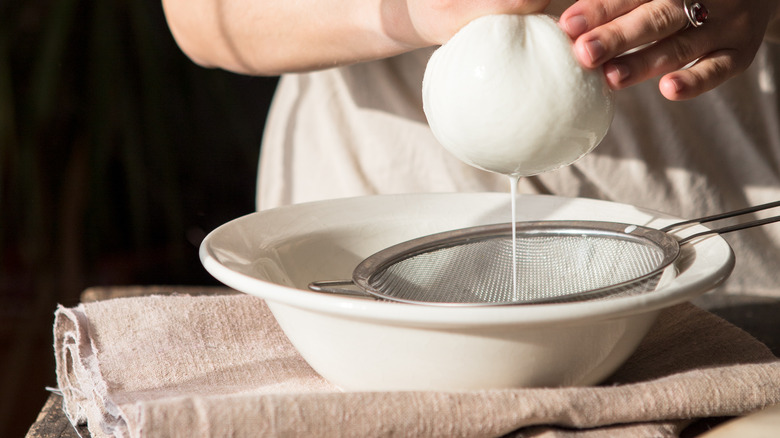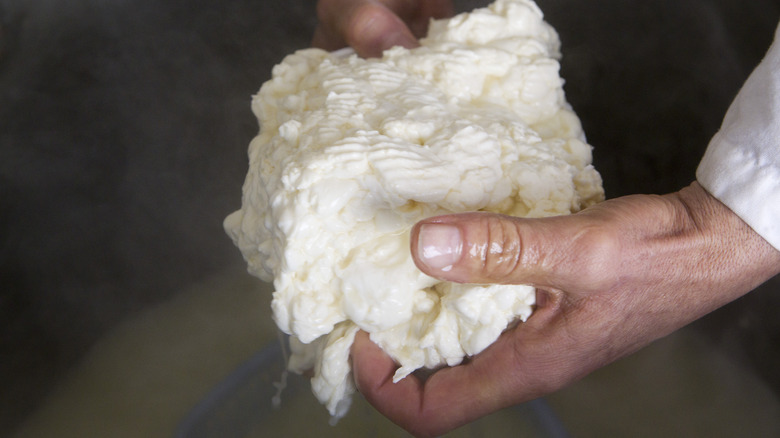Why You Should Stop Using Unstrained Ricotta Cheese For Baking
Ricotta is a cheese that can play both sides of the fence: For every savory preparation in which it shines — lasagna, ravioli, gnocchi, and so on — there's a sweet counterpart, from cake to cheesecake to various Italian delicacies like cannoli and sfogliatelle. For all its versatility, ricotta can be a bit inconsistent depending on what brand you're using, or even where it comes from. American-made ricottas, for instance, tend to have more liquid than their Italian-made counterparts. That's not usually a big deal in savory recipes, but given pastry's delicate science, watery ricottas can potentially ruin a good bake. Your old-fashioned cheesecake recipe could turn out just right, or it could turn out way too heavy. Your ricotta pie could taste light and lovely, or excess liquid could make the bottom crust soggy.
Luckily, there's a trick that can help you achieve more consistent results: Simply strain that ricotta to remove as much liquid as possible before baking it. Some recipes will even instruct you to strain the cheese before using it without telling you how to do so, but fortunately, it's a simple step, and there are various ways to achieve it, ranging from quick and to-the-point (like spreading it on paper towels so they absorb the water) to longer, more careful methods involving cheesecloth and colanders.
How to strain your ricotta cheese
When you strain ricotta, you're essentially just repeating what the cheesemakers did the first time — separating liquids from solids. There are several ways to do this: On the easier end, you can empty the ricotta into a fine mesh strainer and let it sit in the sink for about half an hour, stirring occasionally. Another quick method is to line a sheet pan with a kitchen towel or a few layers of paper towels, spread your ricotta over it, then cover it with more towels. Weight that with another baking sheet and let it sit for a few minutes as the towels absorb the moisture.
For a more rigorous process — if you're the planning-ahead type — line a strainer or colander with cheesecloth, then transfer the cheesecloth-lined strainer to a larger bowl. Fill the cheesecloth with ricotta and cover the surface with plastic wrap. Put something heavy, like a plate, on top of the plastic wrap, then transfer this whole outfit into the refrigerator for eight hours or so, long enough to push out a bunch of water. Now, you can use it in your recipe as directed.
No cheesecloth? No problem. Use paper towels or coffee filters (dampen them first, and go about the whole process a little more gingerly than you would with cheesecloth, as paper will tear more easily) or even a thin kitchen towel, preferably muslin.
Why is ricotta so watery?
You probably have a general idea of how cheese is made. You heat cultured milk with some kind of coagulating agent until it separates into curds and whey, then you can turn those curds into cheese by pressing them, aging them, and so on. Typically, whey is the byproduct of this process, but ricotta, which is Italian for "recooked," originated as a way to repurpose the whey. To wring out all possible uses, cheesemakers heat the whey one more time, then strain it through cheesecloth. Liquid drips through, and what's left behind is a mild cheese that's a good deal softer than, say, Parmesan or pecorino — better for spooning or spreading than slicing or grating.
What's more, ricotta is even softer here than in Italy. In the U.S., cheesemakers tend to start with fresh milk and add coagulants, which produces a more watery cheese (you don't even have to be a professional to gain an intimate understanding of this process — it's easy to make ricotta at home). The stuff that ends up at grocery stores is fine for many recipes, especially if they don't specify that you should strain the ricotta — go ahead and spread it on toast, layer it in lasagna, or toss it with hot pasta as the basis for an easy sauce. But if you're baking, or if you desire a thicker cheese for a dip or a spread (like if you're making Dorie Greenspan's herby ricotta spoonable), you may want to add the extra step of straining here.


